 |
 |
|
 |
 |
Sacrificial Offering and Pilgrimage |
 |
|
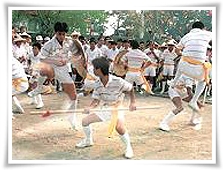 The sacrificial offering ceremony is an important religious event in Cieding. The temples hold this event every few years or a decade and the fishing quarters and family shrine also perform the ceremony. As the village residents become affluent, the ceremonies are becoming extravagance and wasteful, especially ceremonies in the large temples of the major communities. It is a major event in the local communities and the temple follower rush to make donations for the grand celebration. The pilgrimage ceremony is held in the same scale and with the same rituals as the sacrificial ceremony but without the lantern poles and burning of the king ship. Chifu Temple of Upper Cieding holds a pilgrimage every two or three years in between the sacrificial ceremonies. The sacrificial offering ceremony is an important religious event in Cieding. The temples hold this event every few years or a decade and the fishing quarters and family shrine also perform the ceremony. As the village residents become affluent, the ceremonies are becoming extravagance and wasteful, especially ceremonies in the large temples of the major communities. It is a major event in the local communities and the temple follower rush to make donations for the grand celebration. The pilgrimage ceremony is held in the same scale and with the same rituals as the sacrificial ceremony but without the lantern poles and burning of the king ship. Chifu Temple of Upper Cieding holds a pilgrimage every two or three years in between the sacrificial ceremonies.
The so-called sacrificial ceremony (or Jiao) is a large scale ritual held to pay tributes to the Gods. The ceremony often holds the wishing ritual before the tribute (to express thanks to the gods) and the praying rituals are called the blessing Jiao. In September 1982, Jinruan Temple of the lower Cieding area held a celebration for the opening of the new temple called the blessing cerebration.
The sacrificial ceremony has different categories according to the number of days held; there are ceremonies that last one to five days. In general, the periodic festivals are organized quite often, so they are not too extravagant and are smaller in scale. Most of them last for under two days. Cieding's ceremony is an non-periodic event, so organizers are more particular about the ceremonies since they have wait a long time for the next festival. Non-periodic festivals are often events over three days.
|
 |
|

|
The rituals in the sacrificial festival are briefly introduced in the following section: |
| |
|
 |
Building the Altar |
 |
|
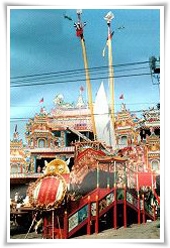 After the preparatory work, building of the altar commences. There are the inside and outside altars. For example, if the inside altar is set up in Chifu Temple, the temple is completed sealed during the festival, allowing access of no one but the priests and festival preparation staff. After the preparatory work, building of the altar commences. There are the inside and outside altars. For example, if the inside altar is set up in Chifu Temple, the temple is completed sealed during the festival, allowing access of no one but the priests and festival preparation staff.
This means to keep the holy place free from contamination. However, the outside altar is open to public viewing and often extravagantly decorated.
|
|
 |
Lantern Poles |
 |
|
The lanterns are a declaration, as well as an invitation, to the gods, deities, and ghosts, of the festival.
The Chinese temple ceremonies are not only blessings to all walks of life but also salvations to the ghosts in the underworld. This is an evidence testifying the tolerance of the Chinese people. The ceremonies give blessings to men and ghosts alike; no wonder, all alien races are eventually assimilated by the culture of the Han ethnic into a fusion of the omnifarious Chinese culture.
|
|
 |
Receiving Holy Water |
 |
|
This ritual is performed to request endowment of holy water for cleaning of the altar.
|
|
 |
Pilgrimage |
 |
|
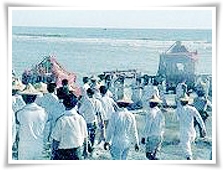 On the second day of the festival, all performing troupes and pilgrims start from the temple square and march out to perform a parade in the outside territory. On the third day after burning of the king ship, the troupes parade on the streets of Cieding and the performing troupes gave their best to perform. Pilgramage is a praying parade giving gods' blessings to the people in the township. On the second day of the festival, all performing troupes and pilgrims start from the temple square and march out to perform a parade in the outside territory. On the third day after burning of the king ship, the troupes parade on the streets of Cieding and the performing troupes gave their best to perform. Pilgramage is a praying parade giving gods' blessings to the people in the township.
|
|
 |
Burning the King Ship |
 |
|
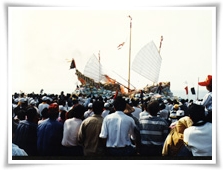 When the festival date is set, a ritual inviting the gods to come is performed and naturally a ceremony to escort them back is also performed at the end. The villagers go on a procession like a festival parade send blessings for to the village. On the third day, the king ship and sacrificial money is burned on the selected auspicious hour to set sail of the god of ship. It is ceremony of prayer for the safely and harvest of the fishing boats. When the festival date is set, a ritual inviting the gods to come is performed and naturally a ceremony to escort them back is also performed at the end. The villagers go on a procession like a festival parade send blessings for to the village. On the third day, the king ship and sacrificial money is burned on the selected auspicious hour to set sail of the god of ship. It is ceremony of prayer for the safely and harvest of the fishing boats.
|
|
 |
Fire Ritual |
 |
|
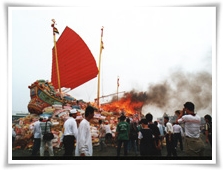 After burning of the king ship, there is another climatic activity, except the procession, that is, the fire ritual. It is commonly known as the fire treading ritual, aiming to burn off the evil omens and empower the spiritual forces. Those with physical discomfort or in mourning are not allowed to participate; however, they can ask someone to hold their clothes when performing the ritual. The clothes represent the person and the gods give blessings for good health. After burning of the king ship, there is another climatic activity, except the procession, that is, the fire ritual. It is commonly known as the fire treading ritual, aiming to burn off the evil omens and empower the spiritual forces. Those with physical discomfort or in mourning are not allowed to participate; however, they can ask someone to hold their clothes when performing the ritual. The clothes represent the person and the gods give blessings for good health.
|
|
 |
Offering and Salvation Ritual |
 |
|
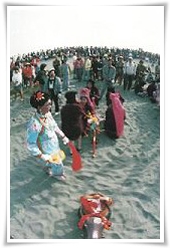 This is the last ritual in the festival. Every household put out sumptuous offerings as offerings to the gods and deities and salvation to the stray spirits. Beggars who come forward on this day is given money as an expression of kindness. After the ritual, a large number of patrons often flood in from all places and every household set up 10 to 20 tables to feast their friends and relatives from out of town. This is an event of gathering and making ties with the families. This is the last ritual in the festival. Every household put out sumptuous offerings as offerings to the gods and deities and salvation to the stray spirits. Beggars who come forward on this day is given money as an expression of kindness. After the ritual, a large number of patrons often flood in from all places and every household set up 10 to 20 tables to feast their friends and relatives from out of town. This is an event of gathering and making ties with the families.
The festival is often held to comfort the anxiety of the villagers and reinforce their faith in the gods. On the day of the festival, families and friends living outside the village are reunited. It is not only an event that draws the ties in the family closer but also establishes solidarity in the communities. And the heritage of folk arts(such as drumming, flag troupes, gong, Songjiang Battle Array, Cisiang, Ox Dance, stilts, Geping, and the Eight General March) find the stage to go on and pass down for generations to come.
|
|
|
| |
|
 |
 |
 |
|
|
|
|
|